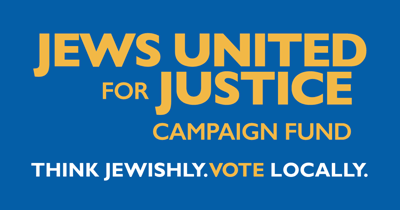See below for JUFJ Campaign Fund testimony on the unfair touch screen ballot system in Montgomery County from Bruce Turnbull, JUFJ Campaign Fund Board member and Montgomery County Campaign Fund team chair.
My name is Bruce Turnbull, and I am appearing to offer testimony on behalf of myself as a Montgomery County voter and on behalf of Jews United for Justice Campaign Fund (JUFJ CF), on whose Board I am a member. I have voted in Montgomery County in every election since 1980, and, while voting in the current Democratic primary election, I encountered an unprecedented ballot situation. As a result of this experience and after consultation with a variety of people, candidates, and organizations, JUFJ CF and I request that the Montgomery County Board of Elections (BOE) take emergency action to fix a ballot design problem that could unfairly impact the outcome of the election for at least one office on the ballot in Montgomery County.
The problem exists in the touch-screen voting system that is currently being used in early voting in Montgomery County. Some candidates for a particular office appear on more than one screen, with no (or, at a minimum, highly ineffective) notice to the voter that there are additional candidates beyond the first screen. The problem is particularly acute in the County Council At-Large Democratic primary ballot, where seven of the eight candidates appear on the first page and the remaining candidate is the only one on the second page. The monitor shows only a small “more” button in the lower right part of the screen, with no indication that the “more” refers to additional candidates for the particular office.
It is entirely possible for voters to believe that they should choose four candidates from the original seven candidate screen. While voters will then be forced to click through to the second screen, anyone who has already selected four candidates from the first screen is unlikely to go back to deselect one of their original picks in order to add the candidate from the second screen.
The same (or a similar) problem appears to exist in one or two of the council district races, where there are also eight candidates, with seven on the first page and one on the second.
In a county where the 2018 Democratic primary election saw the County Executive candidate selected by a margin of 77 votes and one of the state delegates selected by a margin of only 12 votes, even a small number of voters becoming confused by the ballot construction could affect the outcome of the election, to the specific detriment of the candidate who is by herself on the second screen of the At-Large Council listing.
The situation is made even worse by the fact that the paper ballot, and not the touch screen ballot, has been advertised to candidates and the public as the sample ballot, with no warning that the touch screen ballot would be substantially different. This appears to violate the advance notice ballot publication requirements of Maryland Election Law Code Section 9-207. In addition to this, the touch screen ballot likely violates both the state law requirements that ballots must be easily understood by voters and must present candidates in a fair and nondiscriminatory manner. Maryland Election Law Code Section 9-203(1) and (2).
To remedy this situation, the BOE should immediately instruct the provider of software for the touch screen system to modify the presentation of candidates. In the At-Large Council race, if it is not possible to have all eight candidates appear on the same page, we recommend that the first page have three candidates and the second page have five candidates. This will ensure that voters do not select four candidates on the first page without being aware of their additional options on the second page.
If a software fix cannot be made, either during early voting or even by the time of the primary election date of July 19, the BOE must instruct pollworkers to emphasize to voters, both in writing and verbally, that candidates appear on multiple screens for several offices and, in particular, for the At-Large Council race. The BOE should also engage in an immediate, vigorous public information campaign to alert voters to this situation, including through press releases, social media notices, and news media outreach.
Given that early voting is now more than half over, the urgency of this situation cannot be overstated.
Please make sure everyone in your network knows to press the “more” button to see all candidates in each race before selecting their final choices.



